Effects of Doped Hole-Transporting Layers on Perovskite Solar Cell Performances
Abstract
:1. Introduction
2. Materials and Methods
2.1. Device Fabrication and Stability Measurement
2.2. Characterization
3. Results and Discussion
4. Conclusions
Author Contributions
Funding
Institutional Review Board Statement
Informed Consent Statement
Data Availability Statement
Conflicts of Interest
References
- Kojim, A.; Teshima, K.; Shirai, Y.; Miyasaka, T. Organometal Halide Perovskites as Visible-Light Sensitizers for Photovoltaic Cells. J. Am. Chem. Soc. 2009, 131, 6050–6051. [Google Scholar] [CrossRef] [PubMed]
- Best Research-Cell Efficiency Chart, NREL. 2023. Available online: https://www.nrel.gov/pv/cell-efficiency.html (accessed on 20 June 2023).
- Luo, D.; Yang, W.; Wang, Z.; Sadhanala, A.; Hu, Q.; Su, R.; Shivanna, R.; Trindade, G.F.; Watts, J.F.; Xu, Z.; et al. Enhanced photovoltage for inverted planar heterojunction perovskite solar cells. Science 2018, 360, 1442–1446. [Google Scholar] [CrossRef] [PubMed]
- Yip, H.-L.; Jen, A.K.-Y. Recent advances in solution-processed interfacial materials for efficient and stable polymer solar cells. Energy Environ. Sci. 2012, 5, 5994–6611. [Google Scholar] [CrossRef]
- Liu, T.; Chen, K.; Hu, Q.; Zhu, R.; Gong, Q. Inverted perovskite solar cells: Progresses and perspectives. Adv. Energy Mater. 2016, 6, 1600457. [Google Scholar] [CrossRef]
- Hu, Y.; Tang, Y.; Zhang, Z.; Yang, F.; Jiang, L.; Song, Y.; Liu, H. Improving the efficiency of inverted perovskite solar cells by Bis (acetylacetonato) dioxomolybdenum (VI)-doped PEDOT: PSS. Mater. Lett. 2022, 306, 130911. [Google Scholar] [CrossRef]
- Xu, L.; Li, Y.; Zhang, C.; Liu, Y.; Zheng, C.; Lu, W.; Li, M.; Chen, Y.; Huang, W.; Chen, R. Improving the efficiency and stability of inverted perovskite solar cells by CuSCN-doped PEDOT: PSS. Solar Energy Mater. Solar Cells 2020, 206, 110316. [Google Scholar] [CrossRef]
- Liu, D.; Li, Y.; Yuan, J.; Hong, Q.; Shi, G.; Yuan, D.; Wei, J.; Huang, C.; Tang, J.; Fung, M.-K. Improved performance of inverted planar perovskite solar cells with F4-TCNQ doped PEDOT: PSS hole transport layers. J. Mater. Chem. 2017, 5, 5701–5708. [Google Scholar] [CrossRef]
- Niu, J.; Yang, D.; Ren, X.; Yang, Z.; Liu, Y.; Zhu, X.; Zhao, W.; Liu, S. Graphene-oxide doped PEDOT: PSS as a superior hole transport material for high-efficiency perovskite solar cell. Org. Electron. 2017, 48, 165–171. [Google Scholar] [CrossRef]
- Redondo-Obispo, C.; Ripollesa, T.S.; Cortijo-Campos, S.; Álvareza, A.L.; Climent-Pascual, E.; de Andrés, A.; Coya, C. Enhanced stability and efficiency in inverted perovskite solar cells through graphene doping of PEDOT: PSS hole transport layer. Mater. Design 2020, 191, 108587. [Google Scholar] [CrossRef]
- Hu, L.; Sun, K.; Wang, M.; Chen, W.; Yang, B.; Fu, J.; Xiong, Z.; Li, X.; Tang, X.; Zang, Z.; et al. Inverted planar perovskite solar cells with a high fill factor and negligible hysteresis by the dual effect of NaCl-doped PEDOT: PSS. ACS Appl. Mater. Interfac. 2017, 9, 43902–43909. [Google Scholar] [CrossRef]
- Jiang, K.; Wu, F.; Zhang, G.; Chow, P.C.Y.; Ma, C.; Li, S.; Wong, K.S.; Zhu, L.; Yan, H. Inverted planar perovskite solar cells based on CsI-doped PEDOT: PSS with efficiency beyond 20% and small energy loss. J. Mater. Chem. 2019, 7, 21662–21667. [Google Scholar] [CrossRef]
- Huang, P.; Liu, Y.; Zhang, K.; Yuan, L.; Li, D.; Hou, G.; Dong, B.; Zhou, Y.; Song, B.; Li, Y. Catechol derivatives as dopants in PEDOT: PSS to improve the performance of p–i–n perovskite solar cells. J. Mater. Chem. 2017, 5, 24275–24281. [Google Scholar] [CrossRef]
- Zhu, Y.; Wang, S.; Ma, R.; Wang, C. The improvement of inverted perovskite solar cells by the introduction of CTAB into PEDOT: PSS. Solar Energy 2019, 188, 28–34. [Google Scholar] [CrossRef]
- Erazoa, E.A.; Castillo-Bendeck, D.; Ortiz, P.; Cortés, M.T. NaCl doped electrochemical PEDOT: PSS layers for inverted perovskite solar cells with enhanced stability. Synth. Met. 2019, 257, 116178. [Google Scholar] [CrossRef]
- Wang, W.; Qin, F.; Zhu, X.; Liu, Y.; Jiang, X.; Sun, L.; Xie, C.; Zhou, Y. Exploring the Chemical Interaction between Diiodooctane and PEDOT-PSS Electrode for Metal Electrode-Free Nonfullerene Organic Solar Cell. ACS Appl. Mater. Interfaces 2020, 12, 3800–3805. [Google Scholar] [CrossRef] [PubMed]
- Xia, Y.; Dai, S. Review on applications of PEDOTs and PEDOT: PSS in perovskite solar cells. J. Mater. Sci. Mater. Electr. 2021, 32, 12746–12757. [Google Scholar] [CrossRef]
- Wang, Q.; Chueh, C.-C.; Eslamian, M.; Jen, A.K.-Y. Modulation of PEDOT:PSS pH for efficient inverted perovskite solar cells with reduced potential loss and enhanced stability. ACS Appl. Mater. Interfaces 2016, 8, 32068–32076. [Google Scholar] [CrossRef]
- Xue, Q.; Liu, M.; Li, Z.; Yan, L.; Hu, Z.; Zhou, J.; Li, W.; Jiang, X.-F.; Xu, B.; Huang, F.; et al. Efficient and stable perovskite solar cells via dual functionalization of dopamine semiquinone radical with improved trap passivation capabilities. Adv. Funct. Mater. 2018, 28, 1707444. [Google Scholar] [CrossRef]
- Yang, L.; Cai, F.; Yan, Y.; Li, J.; Liu, D.; Pearson, A.J.; Wang, T. Conjugated small molecule for efficient hole transport in high-performance p-i-n type perovskite solar cells. Adv. Funct. Mater. 2017, 27, 1702613. [Google Scholar] [CrossRef]
- Kim, J.H.; Williams, S.T.; Cho, N.; Chueh, C.-C.; Jen, A.K.-Y. Enhanced Environmental Stability of Planar Heterojunction Perovskite Solar Cells Based on Blade-Coating. Adv. Energy Mater. 2015, 5, 1401229. [Google Scholar] [CrossRef]
- Liang, P.-W.; Liao, C.-Y.; Chueh, C.-C.; Zuo, F.; Williams, S.T.; Xin, X.-K.; Lin, J.; Jen, A.K.-Y. Additive enhanced crystallization of solution-processed perovskite for highly efficient planar-heterojunction solar cells. Adv. Mater. 2014, 26, 3748–3754. [Google Scholar] [CrossRef] [PubMed]
- Zhao, Y.; Zhu, K. Optical Bleaching of Perovskite (CH3NH3)PbI3 Through Room-Temperature Phase Transformation Induced by Ammonia. Chem. Commun. 2014, 50, 1605–1607. [Google Scholar] [CrossRef] [PubMed]
- Miccoli, I.; Edler, F.; Pfnür, H.; Tegenkamp, C. The 100th anniversary of the four-point probe technique: The role of probe geometries in isotropic and anisotropic systems. J. Phys. Condens. Matter 2015, 27, 223201. [Google Scholar] [CrossRef] [PubMed]
- Zuo, L.; Guo, H.; deQuilettes, D.W.; Jariwala, S.; De Marco, N.; Dong, S.; DeBlock, R.; Ginger, D.S.; Dunn, B.; Wang, M.; et al. Polymer-modified halide perovskite films for efficient and stable planar heterojunction solar cells. Sci. Adv. 2017, 3, e1700106. [Google Scholar] [CrossRef]
- Terry, M.L.; Straub, A.; Inns, D.; Song, D.; Aberle, A.G. Large open-circuit voltage improvement by rapid thermal annealing of evaporated solid-phase-crystallized thin-film silicon solar cells on glass. Appl. Phys. Lett. 2005, 86, 172108. [Google Scholar] [CrossRef]
- Li, X.; Dar, M.I.; Yi, C.; Luo, J.; Tschumi, M.; Zakeeruddin, S.M.; Nazeeruddin, M.K.; Han, H.; Grätzel, M. Improved performance and stability of perovskite solar cells by crystal crosslinking with alkylphosphonic acid ω-ammonium chlorides. Nat. Chem. 2015, 7, 703–711. [Google Scholar] [CrossRef]
- Wang, Y.; Zhang, T.; Kan, M.; Zhao, Y. Bifunctional Stabilization of All-Inorganic α-CsPbI3 Perovskite for 17% Efficiency Photovoltaics. J. Am. Chem. Soc. 2018, 140, 12345–12348. [Google Scholar] [CrossRef]
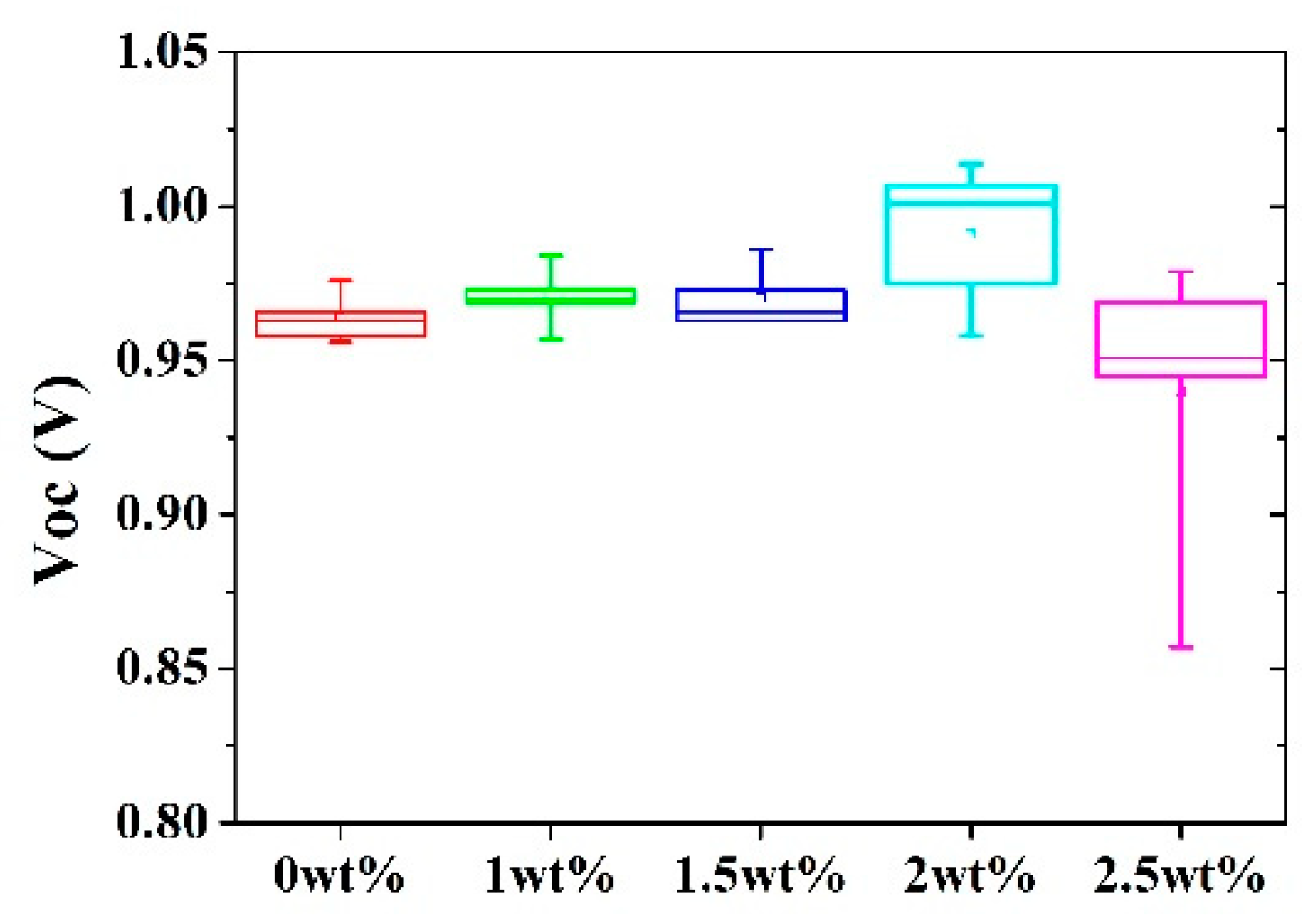
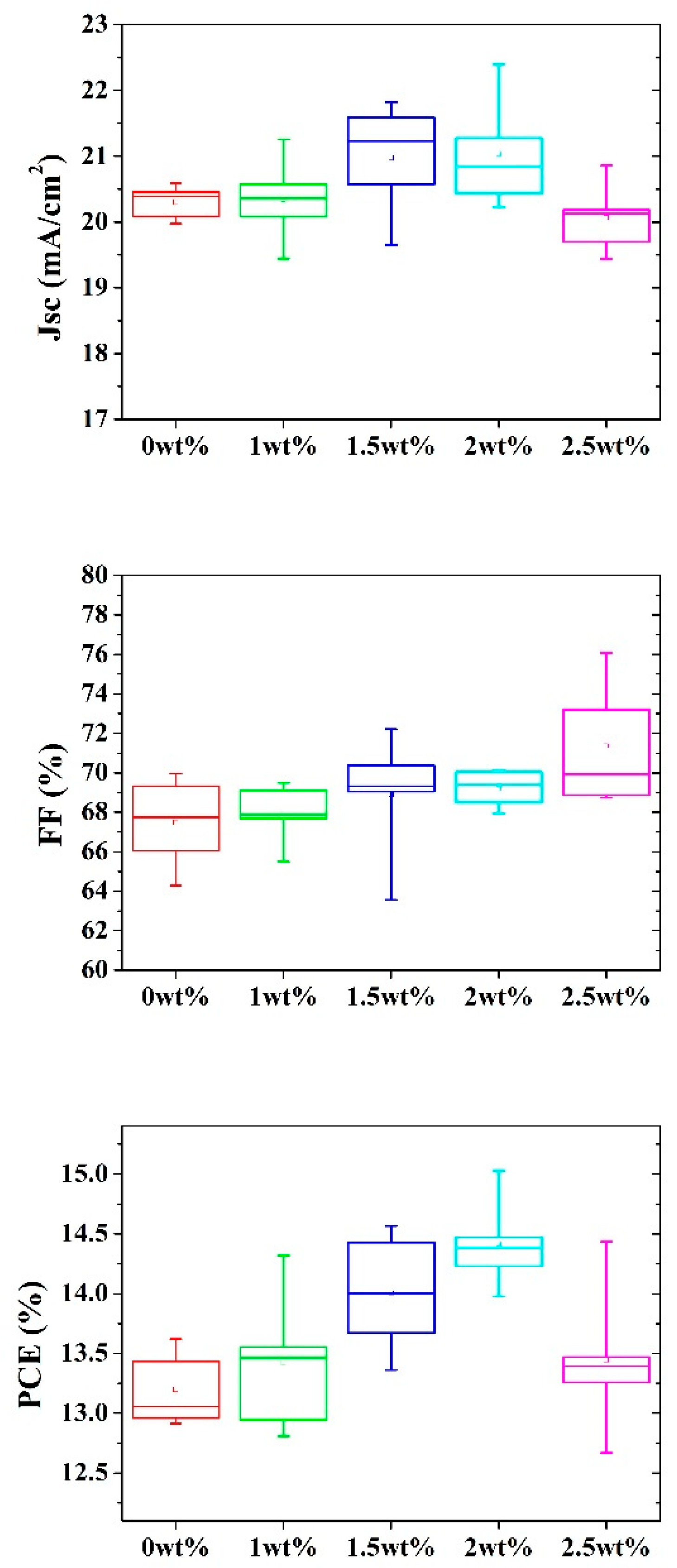

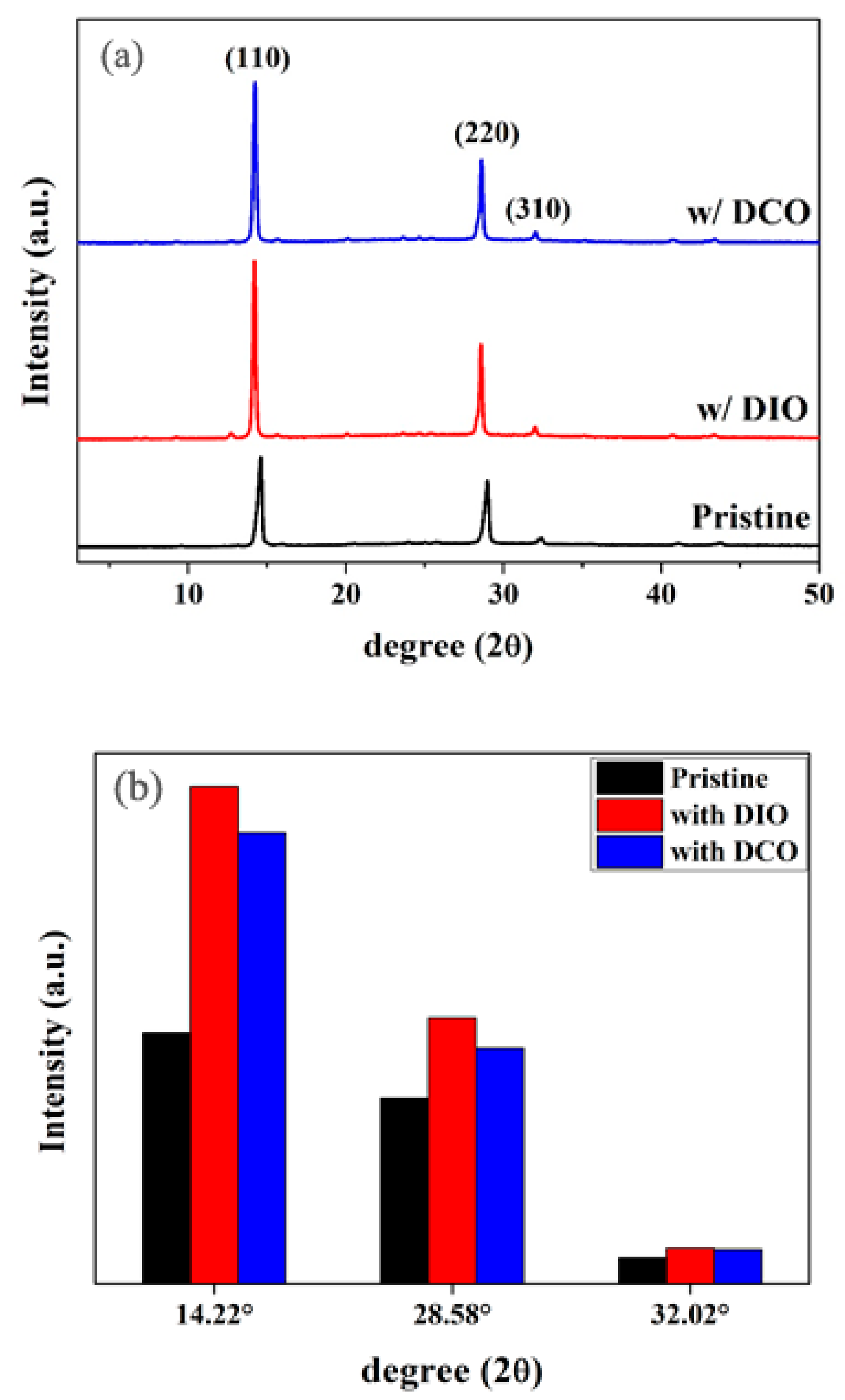


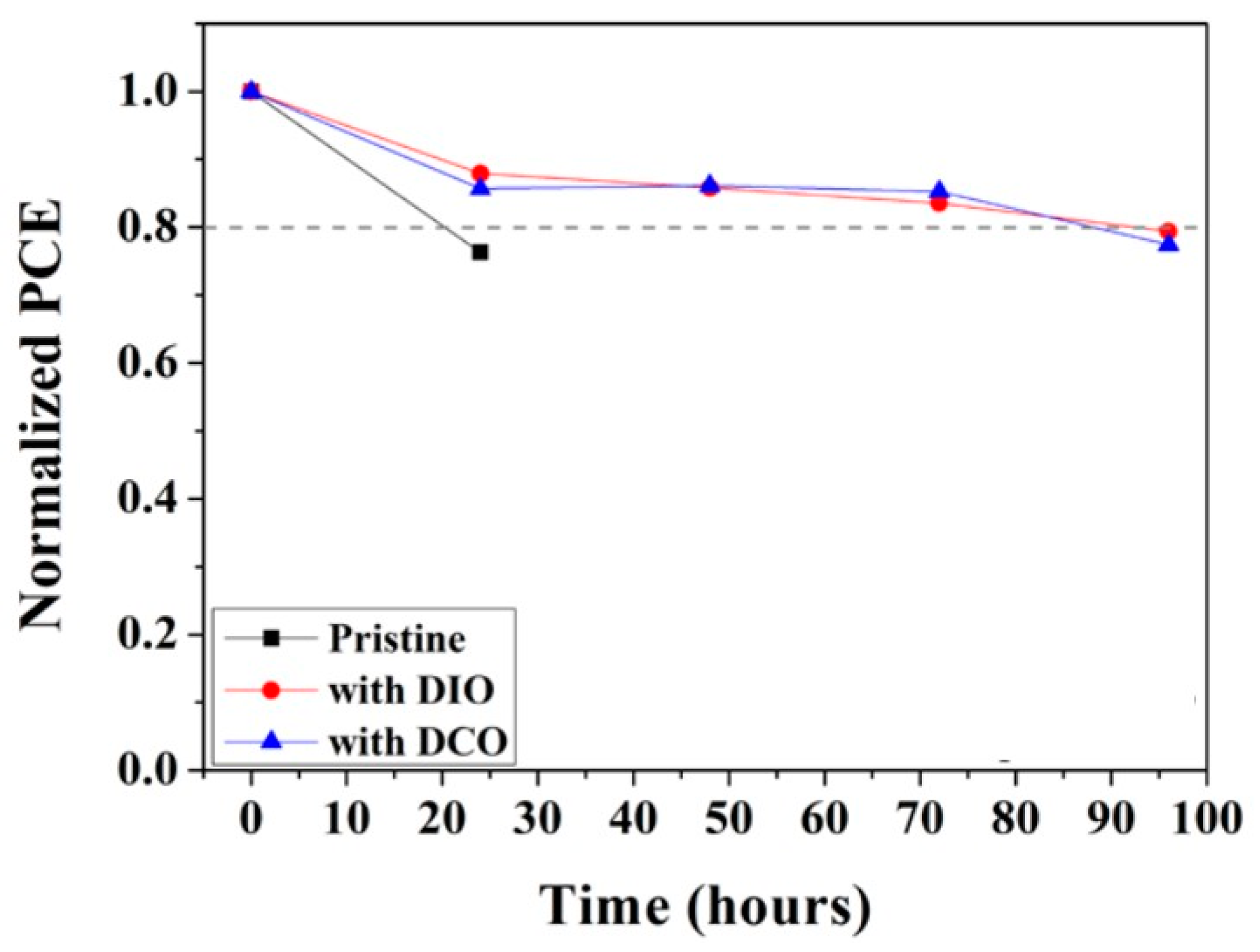

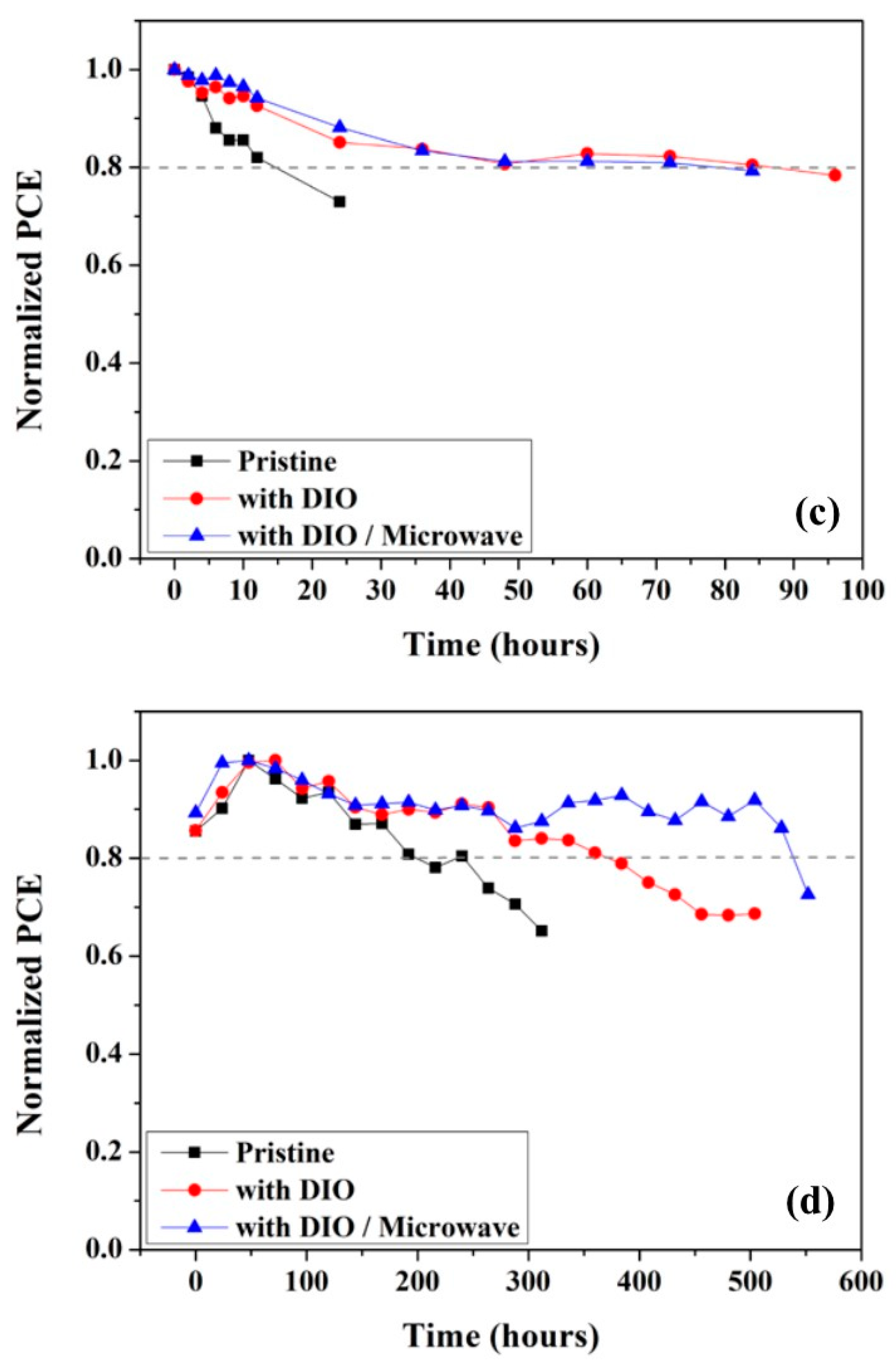
| C (wt%) | VOC (V) | JSC (mA/cm2) | FF (%) | PCE (%) |
|---|---|---|---|---|
| 0 | 0.964 ± 0.008 | 20.30 ± 0.26 | 67.47 ± 2.34 | 13.20 ± 0.31 |
| 1 | 0.971 ± 0.010 | 20.35 ± 0.67 | 67.93 ± 1.57 | 13.42 ± 0.60 |
| 1.5 | 0.970 ± 0.010 | 20.97 ± 0.88 | 68.91 ± 3.23 | 14.01 ± 0.50 |
| 2 | 0.991 ± 0.024 | 21.04 ± 0.86 | 69.20 ± 0.97 | 14.42 ± 0.39 |
| 2.5 | 0.940 ± 0.048 | 20.07 ± 0.54 | 71.37 ± 3.19 | 13.44 ± 0.64 |
| C (wt%) | VOC (V) | JSC (mA/cm2) | FF (%) | PCE (%) |
|---|---|---|---|---|
| 0 | 1.023 ± 0.005 | 19.37 ± 0.59 | 66.85 ± 0.88 | 13.24 ± 0.23 |
| 0.5 | 1.031 ± 0.003 | 20.77 ± 0.71 | 64.34 ± 3.52 | 13.76 ± 0.31 |
| 0.75 | 1.031 ± 0.008 | 21.00 ± 0.89 | 65.57 ± 3.81 | 14.17 ± 0.52 |
| 1 | 1.027 ± 0.008 | 20.68 ± 0.62 | 67.29 ± 3.78 | 14.27 ± 0.52 |
| 1.25 | 1.026 ± 0.025 | 19.91 ± 1.41 | 68.96 ± 4.22 | 14.06 ± 0.48 |
| Conditions | VOC (V) | JSC (mA/cm2) | FF (%) | PCE (%) |
|---|---|---|---|---|
| Thermal, undoped | 0.964 ± 0.008 | 20.30 ± 0.26 | 67.47 ± 2.34 | 13.20 ± 0.31 |
| Thermal, 2 wt% DIO | 0.991 ± 0.024 | 21.04 ± 0.86 | 69.20 ± 0.97 | 14.42 ± 0.39 |
| Microwave, 2 wt% DIO | 0.988 ± 0.019 | 20.64 ± 1.09 | 70.91 ± 2.83 | 14.44 ± 0.54 |
| As Prepared (%) | 1 Day (%) | 2 Days (%) | 3 Days (%) | 4 Days (%) | 5 Days (%) | ||
|---|---|---|---|---|---|---|---|
| Undoped | Before Microwave | 12.69 | 9.01 | - | - | - | - |
| After Microwave | 13.20 | 10.07 | - | - | - | - | |
| DIO doped | Before Microwave | 14.44 | 12.10 | 11.88 | 11.57 | 11.37 | 10.71 |
| After Microwave | 14.61 | 12.84 | 12.54 | 12.21 | 11.60 | 11.19 | |
| Conditions | VOC (V) | JSC (mA/cm2) | FF (%) | PCE (%) |
|---|---|---|---|---|
| Undoped (0.09 cm2) | 0.963 | 20.40 | 69.32 | 13.62 |
| 2 wt% DIO (0.09 cm2) | 0.958 | 22.40 | 70.04 | 15.03 |
| 2 wt% + Microwave (0.09 cm2) | 0.990 | 21.35 | 70.77 | 14.96 |
| Undoped (0.36 cm2) | 0.849 | 19.19 | 61.15 | 9.96 |
| 2 wt% DIO (0.36 cm2) | 0.872 | 21.11 | 65.97 | 12.15 |
| 2 wt% + Microwave (0.36 cm2) | 0.869 | 21.25 | 66.14 | 12.21 |
Disclaimer/Publisher’s Note: The statements, opinions and data contained in all publications are solely those of the individual author(s) and contributor(s) and not of MDPI and/or the editor(s). MDPI and/or the editor(s) disclaim responsibility for any injury to people or property resulting from any ideas, methods, instructions or products referred to in the content. |
© 2023 by the authors. Licensee MDPI, Basel, Switzerland. This article is an open access article distributed under the terms and conditions of the Creative Commons Attribution (CC BY) license (https://creativecommons.org/licenses/by/4.0/).
Share and Cite
Kwon, M.J.; Lee, H.; Jung, J.Y.; Yu, J.-W. Effects of Doped Hole-Transporting Layers on Perovskite Solar Cell Performances. Appl. Sci. 2024, 14, 83. https://doi.org/10.3390/app14010083
Kwon MJ, Lee H, Jung JY, Yu J-W. Effects of Doped Hole-Transporting Layers on Perovskite Solar Cell Performances. Applied Sciences. 2024; 14(1):83. https://doi.org/10.3390/app14010083
Chicago/Turabian StyleKwon, Min Ji, Hyesu Lee, Ji Yoon Jung, and Jae-Woong Yu. 2024. "Effects of Doped Hole-Transporting Layers on Perovskite Solar Cell Performances" Applied Sciences 14, no. 1: 83. https://doi.org/10.3390/app14010083





